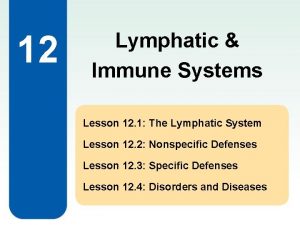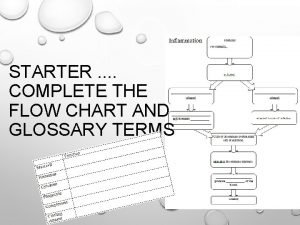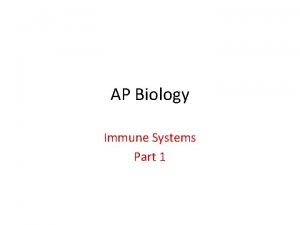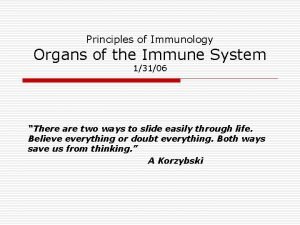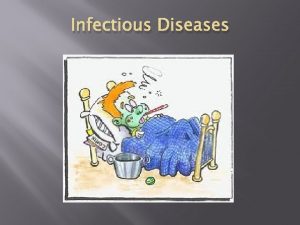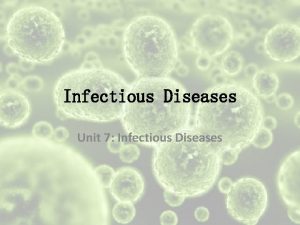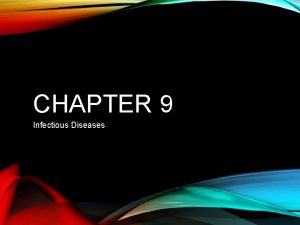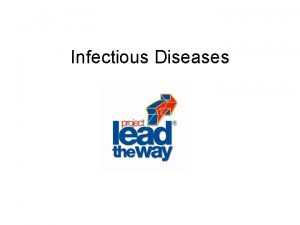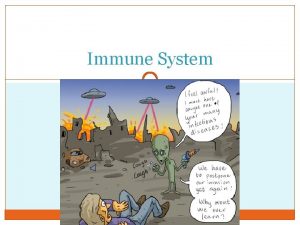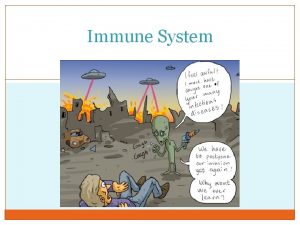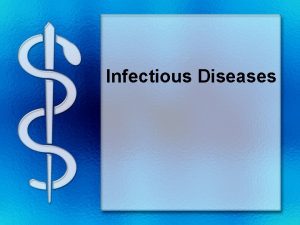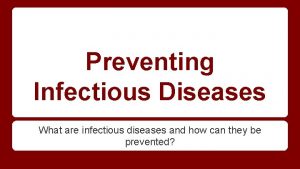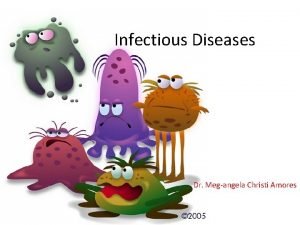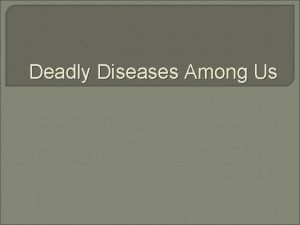Infectious Diseases and The Immune System The Immune




















- Slides: 20

Infectious Diseases and The Immune System

The Immune System �Molecules, cells, and organs in the body �Interactions form a system designed to protect an individual from: �outside invaders � damaged internal cells

Identifying Pathogens Robert Koch 1843 -1910 Studied Anthrax Koch’s Postulates 1. Suspected pathogen occurs in diseased body 2. Isolate suspected pathogen 3. Inoculation of a healthy animal disease 4. This pathogen is isolated and studied *Epidemiologists still use this procedure to study disease

Nonspecific Defenses Innate Able to distinguish foreign tissues and organisms! Reaction occurs regardless of the pathogen �First Line of Defense �Barriers �Skin �Mucous Membranes �Tears �Saliva �Stomach p. H �Ciliated linings

Second Line of Defense �Chemical Agents Lysozymes Histamine The Inflammatory Response Series of events that suppress infection and speed recovery Injury Histamine - Chemical messenger Increased blood flow WBC squeeze out and destroy by phagocytosis Result Redness-swelling-heat-pain


�Second Line of Defense � Nonspecific Effector Cells Neutrophils & Macrophages Phagocytic white blood cells Natural Killer Cells Attack infected cells Attack cancer cells �Temperature Response Fever! Response to infection Greater than 1030 F is dangerous, 105 o. F can cause death! �Proteins: Complement: plasma protein, activated by pathogens Interferon: produced by infected cells

Specific Defenses: The Immune System � Specific- antibody/antigen � Memory- antibodies remaining that remember antigens �Organs: �Bone Marrow stem cells �Thymus � �T Cell maturation �Spleen �WBC/Filter �Lymph Nodes �Filter �Tonsils �Filter

Lymphocytes �B Cells �Directs the production of antibodies (5 types) �T Cells �H=detect infection, tell B cells to produce antibodies �C=attack virus infected cells �S=alerts immune system to stop fighting WBC Differentiation

Recognizing a Pathogen �Antigen recognized foreign substance �Proteins, lipds, polysaccharides, pollen, toxins, venom �Cell receptors �Immune System responds to antigens �Specific! �Memory!


Immune Response �Target is known: MEMORY �Two-part assault on pathogen �Macrophage engulfs pathogen: � displays fragment of pathogen=TROPHY � Interleukin-1 released= activates T cells � attaches to H-T Cell �Cell Mediated Immune Response �Interleukin-2 Stimulates Helper T Cells Stimulates Cytotoxic T Cells Stimulates B Cells

Immune Response �Humoral Immune Response �B Cells �Occurs at the same time the cell mediated occurs �Antibodies produced by plasma cells 30, 000 molecules produced per second Bind to pathogen and inactivate pathogen! Attract phage cells that engulf pathogen


�Primary and Secondary Immune Response �Memory Cells �Lymphocytes recognize and attack �Long term protection against reinfection �Effective throughout life

Immunity and Vaccination �Ability to resist an infectious disease �Primary immune response and survive �Vaccination: dead/weakened pathogen �Jenner 1796 Milk Maids & Cow Pox (vaccinus – from cows) Immunization against Smallpox �Pasteur treats Rabies �Salk injectable Polio vaccine �Booster Shots - Restore Immunity against some diseases Tetanus Varicella

Problems of the Immune System Allergy Response to a “harmless” antigen Symptoms are usually mild… Antihistamines stop the release of histamine

�Asthma �Respiratory disorder that causes bronchioles to narrow �Many different triggers �(smoke, allergens) �Autoimmune Disease �Rare �Body reacts against its own cells �Examples �Multiple Sclerosis �Lupus erythematosis �Rheumatoid Arthritis

Spreading Pathogens Air Food Water Contact Animal bites

 Icd 10 morbus hansen
Icd 10 morbus hansen Epidemiological triad of malaria
Epidemiological triad of malaria A subsequent
A subsequent Chapter 35 immune system and disease
Chapter 35 immune system and disease What is the third line of defense in the immune system
What is the third line of defense in the immune system Lesson 12.1 lymphatic ducts and vessels
Lesson 12.1 lymphatic ducts and vessels Lesson 12 blood and immune system
Lesson 12 blood and immune system Histology of lymphoid tissue
Histology of lymphoid tissue Chapter 6 musculoskeletal system
Chapter 6 musculoskeletal system Chapter 17 reproductive system diseases and disorders
Chapter 17 reproductive system diseases and disorders Chapter 15 nervous system diseases and disorders
Chapter 15 nervous system diseases and disorders Chapter 8 cardiovascular system
Chapter 8 cardiovascular system 10 diseases of lymphatic system
10 diseases of lymphatic system Chapter 26 infectious disease prevention and control
Chapter 26 infectious disease prevention and control Hpps symbol
Hpps symbol What is the third line of defense in the immune system
What is the third line of defense in the immune system Flow chart
Flow chart Third line of defense immune system
Third line of defense immune system 1st line of defense immune system
1st line of defense immune system Ap bio immune system
Ap bio immune system Immune system lymph nodes
Immune system lymph nodes






